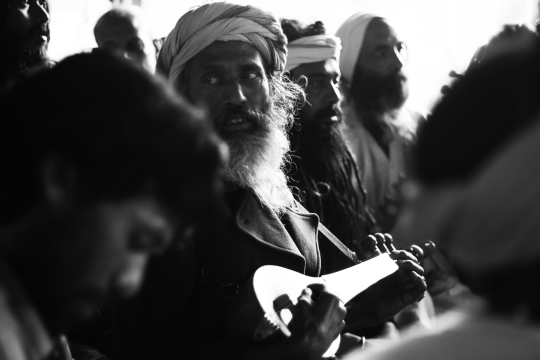“There’re more people trying to separate than to unite [Southasia today]”, says Shazia Khan.
Common is the age-old desire for meaning, fulfillment and novelty, amongst other things. Once when a foreign tradition penetrated through the shores and the mountains of the subcontinent, this desire became the basis for the attraction of Sufism. Besides that, it embraces total immersion, the “mystical layer of spiritual beauty”, which contributed its share to the spread of Islam in India. Sadly this facet has become the very basis for division: The orthodox, Wahabis attacking Sufis for not being in accordance with the “true” Islam, for singing, dancing and their devotion through beauty. The Sufis within Islam, and then the Sufis within Muslims in a somewhat secular India – is all this really that much about religion? Shazia takes us on a journey to find answers to that.
Coming from a Kashmiri Muslim family, being taught the ideals of openness, embracing and valuing other traditions as well, other than her own, instead of following a “dogmatic approach towards practice of religion”, Shazia became a film maker. By now, she has been awarded with the Best Documentary at the India international women’s film festival in 2008 and her documentaries Caravan and Salaam India have been screened at the Al-Jazeera International documentary film festival (2010). Her most recent documentary SAMA – Muslim Mystic Music Of India is about sounds that transmit oceans, Rajasthani Jharokhas and mountains. “I personally feel an urgency to document the diverse tradition of spirituality within the country, as these are some of the few sources that influence, enrich and truly emancipate a society.” From Tamil Nadu to Kerala, Rajasthan, Assam, Jammu and Kashmir and West Bengal, she traces the stories, the tunes and the faces behind the vague word of Muslim mysticism.
This passion, immersion and living in the moment of beauty depicted in each scene seems familiar: Jack Kerouac sought it On the Road, Jim Morrison wanted to Light my Fire. Sama demonstrates that Sufism might be an answer to the question “my house and my family don’t satisfy me anymore, what is there more to life?” – which might be precisely the reason why Sufism as representation of various mystic traditions has become part of the pop-cultural spectrum, including Bollywood and many festivals branding themselves with the soft phonetics of the word “Sufi”. As a filmmaker deeply involved with various degrees of Sufi-practice, Shazia feels that “even if people enjoy this life-style halfway, there’s nothing wrong about this. It’s about the process, like someone climbing a mountain: The one who reaches the top is no better than the one who doesn’t reach.”
But here we see, mainstreaming certain traditions doesn’t equate to greater exposure of its practitioners to wider audiences. Shazia has traveled all over India, to remote villages and communities to document the Manganiyars in Jodhpur or Baul singers in West Bengal. Shazia was the first to film the Kashmiri folk singers around Abdul Rashid. He, a farmer and a folk musician, poses the question of how to bring home the bacon every day. After all, “any musician needs some sort of a commercial mindset to realize the monetary aspect of their work,” says Sonya Mazumdar, founding member of Indiearth. For Shazia, Indiearth has provided her the necessary link between herself as filmmaker, folk musicians and the media.
“Starting out of our own struggle as the music label Earthsync, we created Indiearth as a platform to promote non-mainstream music, unfortunately a sphere without much structure in India,” Sonya tells me. Beyond linking the cultural scene, Earthsync, the label out of which Indiearth emerged, has demonstrated to deliver not only novel content but also perspectives deviating from the mean. The Laya Project, where Earthsync went along the shores of the Indian ocean after the 2004 Tsunami, brings tunes of hope, tradition and life, even under the usual volley of devastation and despair after such events. Presenting the beauty of the rich folk traditions of mystic artists was also Shazia’s aim; “I didn’t look for any pan-religious interpretation or message specifically.”
Painting an aesthetically valuable image is a part of the discourse and the dialectics as much as reporting and debating. “I wish the debates around Sufism and mysticism within India, Islam and the modern world would reach out further to the common men, and not be confined to some festivals and salon-Sufis.”
Overall, Shazia takes us on a rare journey, through human faces, sadly often veiled behind the thick curtains of stale-bread-discourse on Islam, Kashmir, Assam.
“The nature of humans is rediscovering themselves.” Shazia rediscovered not only untold stories of Muslim Mystic cultures in India, but also our selfs. A discovery with the potential to combine raging dichotomies beautifully.














